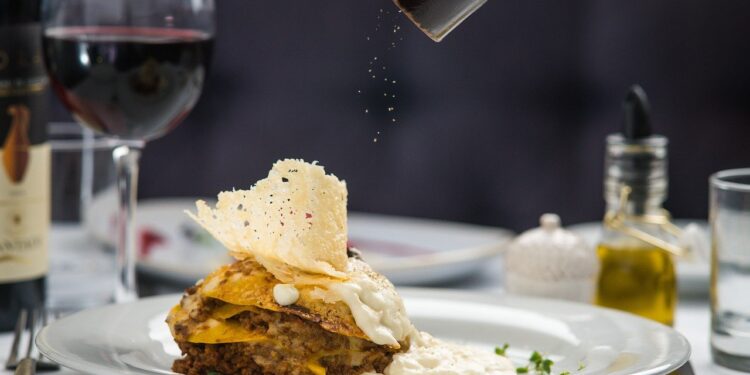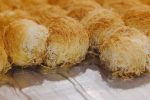3 lasagne recipes beyond the classic Bolognese version

Lasagne is magical. Layers of pasta, ragù and besciamella that fill you up with cosiness and every nutritional element you may require, and even get better as the flavours meld in the fridge after a couple of days. It’s easy, wholesome and delicious. What else do we need?
Well, this might blow your mind, but what you know as classic lasagne is actually only one version of the dish. Pasta Evangelists have compiled a list of many alternative lasagne recipes, explaining: “Most of us are familiar with traditional lasagne alla bolognese, but there are many regional takes on this Italian staple using a range of seasonal ingredients.” So, if you love lasagne as much as us, here are three regional recipes you will want to try.
Lasagne alla Genovese
Genoa is known for its fragrant pesto, so it’s no surprise that the sauce in their lasagne is the basil marvel. Replacing the ragù, it’s a vegetarian alternative that’s light and airy. If you want to think outside of the box, you can opt for other types of pesto, however, we believe the original Genovese basil-based specialty is a winner.
Ingredients
For the pesto
- 80g fresh basil
- 2-3 tbsp extra virgin olive oil
- 60g parmesan
- 40g pine nuts, toasted
- 1 clove garlic, sliced
For the lasagne
- 400g fresh lasagne sheets
- 50g parmesan
- 250g fresh mozzarella
- 100g potato, diced
- 100g green beans, cut into thirds
Method
- First, prepare the pesto. In a pestle and mortar, grind the garlic and pine nuts. When a paste forms, remove from the mortar.
- Add the basil and some salt to taste, then grind until deep green and smooth. Combine with the pine nut mixture using the pestle.
- Slowly incorporate the oil and parmesan until creamy and slightly chunky.
- In a large pan of boiling water, cook the potatoes until tender, 7-10 minutes. Strain and set to one side.
- In a separate pan, boil water and add the green beans, blanching for 5 minutes. Strain and add to a bowl of ice cold water.
- Assemble your lasagne: Ladle a thin layer of pesto on the bottom of a medium-sized baking dish. Top with a layer of lasagne sheets, then one of pesto. Scatter potatoes and beans, and finish with a layer of mozzarella and parmesan.
- Repeat the process around 5 more times, then top with a generous sprinkling of parmesan.
- Cook at 180°C for 20-30 minutes, covered with foil for the first 10-15.
- Let stand for 5 minutes before cutting into the lasagne and garnishing with pine nuts.
Lasagne alla Norma
The island of Sicily is home to some of the best Italian dishes, and this lasagne is quintessential to the region. Incorporating traditional Mediterranean ingredients like tomatoes, aubergines and basil, this combo of moussaka and lasagne is a favourite among many. As the stars of this dish, it’s important to use good quality produce. Picking San Marzano tomatoes over other varieties, for example, can truly make or break this recipe.
Ingredients
For the lasagne
- 250g fresh lasagne sheets
- 400g San Marzano tomatoes
- 350g tomato passata
- 500g aubergine, thinly sliced
- 2 cloves garlic, peeled
- 6 basil leaves, chopped
- 200g ricotta salata, grated
- Extra virgin olive oil
- Salt and pepper to taste
For the ricotta cream
- 500g ricotta
- 100ml whole milk
- Grated nutmeg
- Salt and pepper to taste
Method
- To prepare the tomato sauce, immerse the tomatoes in boiling water, moving into cold water and then removing the skin. Cut in half, get rid of the pips, and chop the tomatoes finely.
- Heat oil in a frying pan and add the garlic cloves, allowing them to brown. Pour the tomatoes in, then cook for 5-10 minutes until soft.
- Stir in the passata and cook for a further 10 minutes. Before it finishes cooking, add the basil and season. Remove from the heat and set aside.
- In another frying pan, heat some oil and fry the aubergines on both sides until golden, topping up the oil if necessary. Once fried, place onto kitchen paper to absorb any excess oil.
- For the ricotta cream, combine the cheese and milk in a bowl and whisk until smooth. Sprinkle with salt, pepper and nutmeg.
- Ladle a thin layer of tomato sauce at the bottom of a medium-sized baking dish. Place a layer of lasagne sheets on top.
- Add another layer of tomato sauce, then ricotta cream, then aubergine, and finish off with ricotta salata.
- Repeat the process until the dish is full, about 3 times.
- Bake at 200°C for 20 minutes, until the pasta is cooked through.
- Allow to stand for 5 minutes and serve with grated ricotta salata.
Lasagne Bianca
Lasagne bianca — literally ‘white lasagne’, as it doesn’t contain any tomatoes — is a recipe chock-full of cheesy goodness. As a Pugliese specialty, the dish incorporates the most well-known cheese of the region, the burrata. You should try and source authentic, good quality burrata for this recipe, as it is essential for the unique and mouth-watering flavour of the lasagne.
Ingredients
- 500g lasagne sheets
- 400g fresh burrata
- 700ml homemade besciamella
- 500g fresh porcini mushrooms, cleaned and chopped
- 100g parmesan or pecorino
- 1-2 cloves garlic
- ½ glass white wine
- 1 handful fresh parsley, chopped
- 2 tbsp extra virgin olive oil
- Butter
- Salt and pepper to taste
Method
- Heat oil in a frying pan and cook the garlic, then add the mushrooms and fry until browned.
- Lower the flame and pour in the wine, parsley, salt and pepper.
- Allow to cook for 40 minutes until soft. If the sauce gets too dry, add more wine.
- Stir in a little of the besciamella to the mushroom sauce, turn off the heat and let marinate.
- Remove the garlic from the pan.
- Cut the outer part of the burrata into small pieces, keeping the soft insides in a separate bowl.
- Grease an oven dish with some butter and fill the bottom with lasagne sheets.
- Layer besciamella and mushroom sauce and cover with burrata and grated parmesan.
- Repeat until the dish is almost full, and top with besciamella, the stracciatella (the creamy insides of burrata), the remaining parmesan and small bits of butter.
- Bake at 180°C for 30 minutes.
- Wait 5 minutes before serving.








